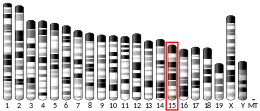Complement component 9
Complement component 9 (C9) is a MACPF protein involved in the complement system, which is part of the innate immune system.[5] Once activated, about 12-18 molecules of C9 polymerize to form pores in target cell membranes, causing lysis and cell death.[6] C9 is one member of the complement membrane attack complex (MAC), which also includes complement components C5b, C6, C7 and C8.[7][8][9] The formation of the MAC occurs through three distinct pathways: the classical, alternative, and lectin pathways.[7] Pore formation by C9 is an important way that bacterial cells are killed during an infection, and the target cell is often covered in multiple MACs. The clinical impact of a deficiency in C9 is an infection with the gram-negative bacterium Neisseria meningitidis.[10]
| C9 | |||||||||||||||||||||||||||||||||||||||||||||||||||
|---|---|---|---|---|---|---|---|---|---|---|---|---|---|---|---|---|---|---|---|---|---|---|---|---|---|---|---|---|---|---|---|---|---|---|---|---|---|---|---|---|---|---|---|---|---|---|---|---|---|---|---|
| |||||||||||||||||||||||||||||||||||||||||||||||||||
| Identifiers | |||||||||||||||||||||||||||||||||||||||||||||||||||
| Aliases | C9, ARMD15, C9D, complement component 9, complement C9 | ||||||||||||||||||||||||||||||||||||||||||||||||||
| External IDs | OMIM: 120940 MGI: 1098282 HomoloGene: 74406 GeneCards: C9 | ||||||||||||||||||||||||||||||||||||||||||||||||||
| |||||||||||||||||||||||||||||||||||||||||||||||||||
| |||||||||||||||||||||||||||||||||||||||||||||||||||
| |||||||||||||||||||||||||||||||||||||||||||||||||||
| |||||||||||||||||||||||||||||||||||||||||||||||||||
| |||||||||||||||||||||||||||||||||||||||||||||||||||
| Wikidata | |||||||||||||||||||||||||||||||||||||||||||||||||||
| |||||||||||||||||||||||||||||||||||||||||||||||||||
Structure
C9 genes include 11 exons and 10 introns when found in fish.[11] In fish, the liver is the site where the majority of complement components are produced and expressed, but C9 can also be found in other tissues.[11] It is a single-chain glycoprotein with a four domain structure arranged in a globular bundle.[10][11]
Pore formation
MAC formation starts with the assembly of a tetrameric complex with the complement components C6, C7, C8, and C5b.[12] The final step of MAC on target cell surfaces involves the polymerization of C9 molecules bound to C5b8 forming C5b-9.[8][10][11] C9 molecules allow cylindrical, asymmetrical transmembrane pores to form. The overall complex belongs to MAC/perforin-like (MACPF)/CDC superfamily.[6] Pore formation involves binding the C9 molecules to the target membrane, membrane molecules forming a pre-pore shape, and conformational change in the TMH1, the first transmembrane region, and TMH2, the second transmembrane region.[8] The formations of pores leads to the killing of foreign pathogens and infected host cells.
Relation to aging process
C9 was found to be the most strongly under expressed serum protein in men who achieved longevity, compared to men who did not. [13]
References
- GRCh38: Ensembl release 89: ENSG00000113600 - Ensembl, May 2017
- GRCm38: Ensembl release 89: ENSMUSG00000022149 - Ensembl, May 2017
- "Human PubMed Reference:". National Center for Biotechnology Information, U.S. National Library of Medicine.
- "Mouse PubMed Reference:". National Center for Biotechnology Information, U.S. National Library of Medicine.
- Lint TF, Zeitz HJ, Gewurz H (November 1980). "Inherited deficiency of the ninth component of complement in man". Journal of Immunology. 125 (5): 2252–7. PMID 7430628.
- Dudkina NV, Spicer BA, Reboul CF, Conroy PJ, Lukoyanova N, Elmlund H, et al. (February 2016). "Structure of the poly-C9 component of the complement membrane attack complex". Nature Communications. 7 (1): 10588. Bibcode:2016NatCo...710588D. doi:10.1038/ncomms10588. PMC 4742998. PMID 26841934.
- Mohapatra A, Das S, Dey S, Sahoo PK (April 2020). "Molecular characterization and induced expression analysis of the terminal complement component C9 in rohu, Labeo rohita". Aquaculture Research. 51 (4): 1415–1427. doi:10.1111/are.14487. ISSN 1355-557X. S2CID 213565293.
- Spicer BA, Law RH, Caradoc-Davies TT, Ekkel SM, Bayly-Jones C, Pang SS, et al. (August 2018). "The first transmembrane region of complement component-9 acts as a brake on its self-assembly". Nature Communications. 9 (1): 3266. Bibcode:2018NatCo...9.3266S. doi:10.1038/s41467-018-05717-0. PMC 6093860. PMID 30111885.
- Wickramaarachchi WD, Wan Q, Lee Y, Lim BS, De Zoysa M, Oh MJ, et al. (October 2012). "Genomic characterization and expression analysis of complement component 9 in rock bream (Oplegnathus fasciatus)". Fish & Shellfish Immunology. 33 (4): 707–17. doi:10.1016/j.fsi.2012.06.019. PMID 22796422.
- Fu X, Ju J, Lin Z, Xiao W, Li X, Zhuang B, et al. (July 2016). "Target deletion of complement component 9 attenuates antibody-mediated hemolysis and lipopolysaccharide (LPS)-induced acute shock in mice". Scientific Reports. 6 (1): 30239. Bibcode:2016NatSR...630239F. doi:10.1038/srep30239. PMC 4957234. PMID 27444648.
- Li L, Chang MX, Nie P (August 2007). "Molecular cloning, promoter analysis and induced expression of the complement component C9 gene in the grass carp Ctenopharyngodon idella". Veterinary Immunology and Immunopathology. 118 (3–4): 270–82. doi:10.1016/j.vetimm.2007.05.005. PMID 17604124.
- Fu YW, Zhu CK, Zhang QZ (May 2019). "Molecular characterization and expression analysis of complement components C3 and C9 in largemouth bronze gudgeon (Coreius guichenoti) in response to Ichthyophthirius multifiliis infection". Aquaculture. 506: 270–279. doi:10.1016/j.aquaculture.2019.03.046. S2CID 133378035.
- Orwoll E, Wiedrick J, Nielson C, et al. (2020). "Proteomic assessment of serum biomarkers of longevity in older men". Aging Cell. 19 (11): e13253. doi:10.1111/acel.13253. PMC 7681066. PMID 33078901.
External links
- Complement+9 at the US National Library of Medicine Medical Subject Headings (MeSH)
- PDBe-KB provides an overview of all the structure information available in the PDB for Human Complement component C9



